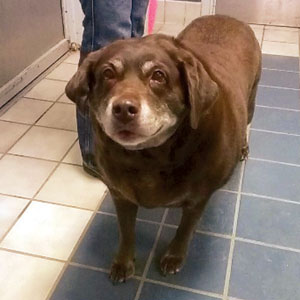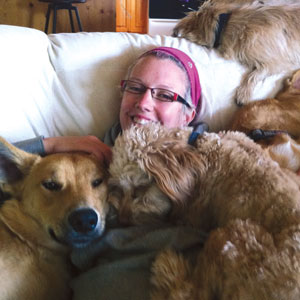

How to Get Started Fostering Dogs
Foster families, the unsung heroes of rescue work, offer love, compassion, and temporary shelter to dogs en route to their happy ending—a place to call home
I’ve adopted many dogs in my lifetime, dogs from shelters, from rescue groups, and once even from an acquaintance when it was evident that the puppy was failing to thrive and would likely die. The dogs have been big, small, and even toy. Their ages have ranged from newborn pup to senior dog. All had one thing in common though—I knew they were forever mine from the moment I wrapped my arms around them. But for the fosterers of rescue dogs, their loving arms and warm hearths are not forever, but just for now and because of that, many more dogs can be saved.

Without dog fosterers—without that vital step—many adoptions would never be possible. No-kill shelters are the exception, not the rule, and many, many dogs are euthanized simply because there is nowhere to house them; fostering offers a reprieve. Furthermore, many dogs—those that are too stressed by the shelter environment or those in need of recuperative care or training—don’t fare well in a shelter environment, making it difficult to appeal to would-be adopters.
The latter was the case with Yukon, an 11-month-old red and white Siberian Husky that had already been returned to the shelter three times. Even the most well-meaning adoptive family proved no match for Yukon’s very high energy level and demands, which is why he was surrendered in the first place.
“Someone saw him—a neighbour—and convinced the owner to surrender the dog. He was howling and looked stressed,” says Shannon Briggs, president of the Vancouver Island Dogs Rescue Society and foster mom. “He had limited placement options.”
So Briggs herself fostered him as he fit in with her own pack, which included two Huskies, and began addressing his serious separation anxiety and boundary issues. All vetting was done (shots, neutering, and tattoo) and she started him on basic obedience training.
Then, fate smiled on Yukon; a couple saw his photo on the Society’s Facebook page, fell in love, and adopted him. This is yet another upside for dogs in foster care; once out of the shelter and into a real, though temporary, home, they have a greater chance of being seen by potential adopters.
“They were Husky owners and lived a block away,” Briggs says, which meant the home visit and introduction to his new pack were a breeze to arrange. “I still see him. It’s awesome.”
The commitment, she says, is to foster until the dog is adopted, providing love and training with the goal of assisting the dog in finding and keeping a forever home.
Which isn’t to say she found it easy to give up Yukon or any other foster dog, for that matter. It’s not so much sad as bittersweet, she says. One realization keeps her going: “I see the next dog. I see all the dogs we say no to…if I keep one, I can’t foster anymore.”
Robin Kennedy feels the same way. She volunteers with Southside Animal Shelter in Indianapolis, Indiana, which places about 500 animals each year, taking 95 percent of their animals from municipal shelters, which are full or unable to find adoptive homes due to an animal’s disposition.
She often hears people say they wish they could take all the dogs in and save them. “But they can’t, so [they should] just take one and give it a chance,” she says. “Every dog fostered saves two lives: one that’s in the home and the space in the shelter where another one can stay so it doesn’t die.”
She has fostered 106 animals (a third of which were dogs) and is always trying to find others to foster as well. The special needs ones, though, she takes on herself. Like Penny, an eight-year-old Pomeranian surrendered to a veterinarian to be euthanized for medical issues. She hads an enlarged heart, collapsing trachea, and two hernias. “She was so sweet,” Kennedy explains, “that the vet couldn’t do it so they called the organization and said, ‘Will you take Penny?’”
Penny stayed with Robin for a year before being adopted by a retired dentist. Robin described Penny’s medical conditions and medication requirements but the man said not to worry, he takes heart medications and has had a hernia himself. Penny spent the entirety of his initial visit in his lap.
“I do fall in love but I also know if you don’t let go, you can’t help another,” says Kennedy. “Before Penny left, as I was giving him the spiel, there were tears in my eyes but I knew he was the best home for her.”
She has five more dogs in her care right now and she hopes they will all move on at some point.
“I give them the best start I can. They come in scared, sick, have medical issues, and need a place to get better. When they’re in the best health, I give them the best start for the rest of their lives. I don’t know if I will ever own a dog again.”
For others, it was offering a forever home that introduced them to fostering.
Craig Smith and his wife Sara live in Invermere, BC. They adopted two pups from a foster home working with a rescue group. Those dogs, Julius Ceasar and Foxy Brown, now two-and-a-half, are mixed breeds that had been tossed in a dumpster.
“I think they are Lab-Shepherd-Husky cross. They look like dingoes,” he says, noting they are “such amazing, well-mannered dogs. They are like the Dr, Phil of dogs.” Their great experience with their rescue dogs led them to think about fostering.
The Smith’s first foster, arranged through Global Animal Lovers Society (GALS) was an abused, incredibly timid female who cowered in the corner. Their own dogs were able to calm her and allow her to behave like a dog. In less than four weeks, she was ready for her permanent home. Smith loves seeing updates on her with her new family posted to the GALS Facebook page.
Then he and his wife heard about some Chihuahuas that had been scheduled for euthanasia in Los Angeles but were now being flown in to GALS. The Smiths committed to adopting one, a female named Raposa, and fostering the five others as needed. It turned out only one was without a place to stay, a wee guy named Shakes. Unbeknownst to the Smiths, Shakes and Raposa had been cage-mates.
“It was amazing how well they got along; they were so excited to see each other. They had bonded so incredibly and [also] with our big dogs, and we didn’t have the heart to separate them,” says Craig Smith. He and his wife adopted both and now, with four dogs, have a 100 percent complete family.
In the animal rescue world, this is what’s known as a foster failure: when the foster parent adopts the dog. It’s a happy, wonderful kind of failure, but certainly adoption isn’t the expectation. The expectation is repairing the dog’s medical and emotional hurts to ready them for adoption. And that is why there is some care and attention to selecting foster parents and then matching them with the right dog.
“Ideally, [fosterers] are enthusiastic and interested and have realistic expectations on what a dog can bring and what they can manage,” says Kath Oltsher, fosterer and co-founder of Zoe’s Animal Rescue Society in Edmonton, AB. “If they don’t have experience, then time, space, and enthusiasm can play a huge part of a good foster. It’s going to be a little bit of work, an emotional commitment, and there are objectives to be met like vet appointments and behaviour issue reporting. We try to get a sense of the personality of a person to match the personality of the dog.”
If a foster home is needed for only a few days or weeks, then the match isn’t quite so important. And sometimes the match is made because no one else can take that dog.
Oltsher has fostered more than 40 dogs and puppies including Celine, a two-year-old Pug mix, and her three pups. They had been living in a ditch in a rural area where dogs ran rampant; Zoe’s was scheduled to bring a mobile spay and neuter clinic there.
“Celine had sarcoptic mange and her six-to-seven-week-old puppies had it too. They had little hair, bloody and scabby skin. They scraped themselves in desperation to relieve the itch. It’s irritating but incredibly treatable.”
It’s difficult to find a rescue that can take dogs with communicable diseases, so they were plucked from the ditch and Oltsher, who is known for taking the difficult cases, took them home herself. She had to wear gloves and protective clothing and keep the dogs isolated from her own dogs for the first weeks. The dogs whimpered with joy the first time she could put her bare hands on them. Within six weeks, they had been nursed to a good weight and were free of parasites.
“The way I explain fostering is there are times when you cry from pure sadness and desolation and times you cry from happiness. It’s hard, but it’s not unhappy when I know where they’re going. It’s difficult to say goodbye because you love them and have invested yourself in them to give them a chance at an excellent life. That’s the point of fostering. For me it’s important to know they are going to a good place, then I am free to do it again.”
Often, she says, volunteer fosterers will develop rituals to help them say goodbye. One volunteer keeps a photo album. Another has a canvas where she takes paw prints of each dog she fosters. That volunteer is already on her second canvas.
Dogs, says Oltsher, don’t know if their lives are long or short; they just know if they are happy. When it’s time to move into their new homes, they remain happy.
“The moment a dog leaves through the door I say, who can I bring in? Who’s next?”
INTERESTED IN FOSTERING
Reach out to your municipal shelter, SPCA or breed-specific rescue group. Pretty much everybody is in need of fosterers. A foster application and a home check—when a representative from the group comes to check out your home—are pretty standard practice. Then just sit back and await your first charge. (They will ask if you’ll take on a particular dog; you can say yes or no.). Foster dogs can stay with their foster families anywhere from a couple days to months, during which time you’ll have the heart-expanding joy of seeing a discarded dog blossom, the recipient of a second chance that is sadly all to rare. It doesn’t get much more rewarding!
Join the newsletter and never miss out on dog content again!
"*" indicates required fields
By clicking the arrow, you agree to our web Terms of Use and Privacy & Cookie Policy. Easy unsubscribe links are provided in every email.




